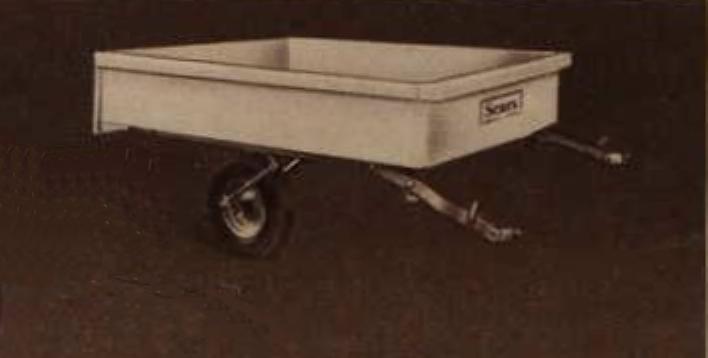
Allstate – Steel Box
By the Fall–Winter 1963 Sears Catalog, the company proudly introduced what it described as “Our Best ALLSTATE All-Steel Trailer.” This announcement marked yet another refinement in Sears’ long-running tradition of practical, affordable, and versatile hauling equipment. For the first time, Sears offered both a two-wheel and a single-wheel version of the trailer, each designed with the same general dimensions and styling. The construction featured a separate steel frame and detachable body, a configuration that allowed greater customization for owners who wished to adapt the trailer to specific uses. For those seeking a more economical option or preferring to construct their own cargo body, Sears also sold the frame alone for $10 less than the complete trailer. The standard color finish for both models was a clean beige enamel, consistent with the restrained industrial aesthetic popular during the early 1960s.
Sometime after the publication of the 1965 Sears Fall Catalog, a notable design evolution took place: the company discontinued the separate frame offering and transitioned the trailer to a fully integrated unibody construction. This advancement meant that the frame and body were now a single, welded structure, increasing rigidity while reducing assembly complexity. The unibody design was also cleverly engineered to accommodate both single-wheel and two-wheel configurations. Mounting holes for the two-wheel leaf spring suspension were located on either side of the body, while a central set of holes was provided for attaching the single-wheel assembly, making the chassis truly multipurpose.
At the time of its introduction, the factory price for the single-wheel version began at $85.00, a competitive figure for a fully steel-bodied trailer of its size and quality. By the Spring 1964 Catalog, Sears expanded the line’s versatility by offering an optional steel top, designed to provide all-weather protection for cargo. The top was hinged for easy access and sold separately for $37.50, appealing to customers who needed a durable, enclosed storage option for travel or utility use.
Over the following decade, the All-Steel trailer line underwent a series of incremental design and branding updates that reflected both functional improvements and evolving mid-century styling trends:
-
1966 Fall Catalog: The trailer’s front logo changed from ALLSTATE to the more contemporary SEARS mark, signifying a shift in branding as Sears phased out its Allstate name for many automotive products. The color changed from beige to tan enamel, and the price slightly decreased to $77.00.
-
1967 Spring Catalog: The finish was updated again, this time to a white enamel coating, aligning with the clean, modern look of the late 1960s. The price, however, rose to $89.00.
-
1968 Fall Catalog: Safety updates began appearing, with the addition of two rear reflectors, and the price increased to $124.95.
-
1969 Spring Catalog: Four side reflectors were added for improved visibility, and the price adjusted to $119.99, likely reflecting material cost fluctuations.
-
1970 Spring Catalog: Major safety upgrades arrived this year — the trailer now included two rear taillights along with the four side reflectors. In earlier years, taillights had been available only as an optional add-on. The new model sold for $139.99.
-
1970 Fall Catalog: The four side reflectors were upgraded to side marker lights positioned in the same locations, enhancing nighttime visibility without changing the $139.99 price.
-
1971 Fall Catalog: The color shifted once again, this time to a rich Cinnamon Brown enamel, but the side lights were downgraded back to four reflectors. The price rose modestly to $149.99.
-
1972 Spring Catalog: Sears added chrome-plated bumper brackets, giving the trailer a more polished, automotive appearance, and increased the price to $154.49.
-
1975 Spring Catalog: Reflecting inflation and rising manufacturing costs during the mid-1970s, the price jumped significantly to $224.95.
Through these years, Sears’ single-wheel and two-wheel trailers remained reliable, accessible options for everyday consumers—favored by campers, tradesmen, and travelers alike. The progression from separate-frame construction to unibody design, along with evolving finishes, safety equipment, and branding, illustrates Sears’ commitment to continuous improvement and adaptation to modern tastes throughout the 1960s and 1970s.